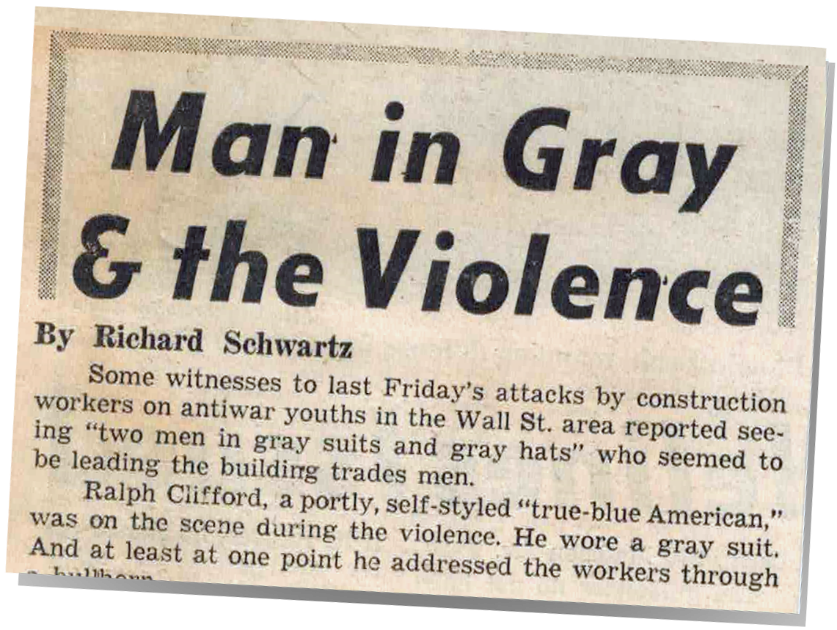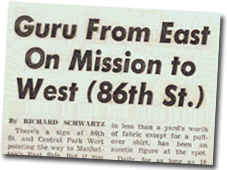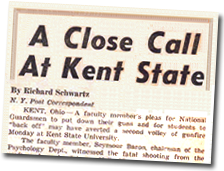
Second Takes
ARTICLE
Wall Street Rampage
Man in Gray & the Violence
By RICHARD SCHWARTZ
Some witnesses to last Friday’s attacks by construction workers on antiwar youths in the Wall St.  area reported seeing “two men in gray suits and gray hats” who seemed to be leading the building tradesmen.
area reported seeing “two men in gray suits and gray hats” who seemed to be leading the building tradesmen.
Ralph Clifford, a portly, self-styled “true-blue American,” was on the scene during the violence. He wore a gray suit. And at least at one point he addressed the workers through a bullhorn.
Cllfford, 53, editor and publisher of a small right-wing newspaper, said he acted on the spur of the moment.
“It was impulsive,” Clifford said. “I saw the guys go by on the way to City Hall and I joined the line.”
This reporter observed Clifford on the steps of Federal Hall, across from the New York Stock Exchange, at 2:30 p.m., nearly an hour after the Friday march on City Hall.
Clifford was standing on the base of the George Washington statute holding a bullhorn. Massed in front of him, near the intersection of Wall and Broad Sts., were 200 workers in hard hats and upwards of 2000 followers.
How did Clifford come to have a bullhorn?
“It was given to me by the Police Dept.,” Clifford said. “Actually, I was asked to speak to the crowd.” Why was he singled out?
“I imagine the captain recognized me and asked me to step up and talk to them [the workers].”
Why would the police recognize him?
“I have no idea,” said Clifford.
Clifford said he had never seen any of the construction workers before.
“It just was that someone had to talk to them. They needed someone to congratulate them for what they had done. They had been frustrated long enough.”
Clifford appeared on the Federal Hall steps moments after some workers had attacked a youth wearing old army clothes. The youth, who had been taking photographs of the workers from atop a newspaper stand, was knocked to the ground, punched and kicked.
A WNEW-TV news assistant, who went to the youth’s aid, was bloodied in the melee.
“I’m glad to see all of us here,” said Clifford, speaking into the bullhorn. “And three cheers for the construction workers.”
Just then two men mounted the steps and placed American flags on either side of Clifford.
“I must tell you something,” the right-wing publisher said. “They [the antiwar demonstrators] are all socialists. All right, now, we’ve proved our point. Let’s go. We’ve shown we are behind the Presidency of the United States.
“Now, before you all create a riot here, we must go home. And let’s have a wonderful weekend.”
Shortly before yesterday’s renewed marches by construction workers, Clifford reappeared. This time he was in the City Hall press room distributing copies of his newspaper, The New York Graphic.
He had not been stopped, so far as could be learned, by the scores of policemen guarding a double barricade in front of City Hall.
The regular security officer at the main entrance remembered having let Clifford through. He said: “I have seen him in here before, bringing papers.”
Most of the reporters were too busy to take notice of Clifford. One had been handed a copy of the paper by Clifford, glanced at it and said, “Oh, that thing again.” He tossed it aside.
Attached to Clifford’s newspaper was a mimeographed leaflet. It took the form of a letter dedicated to “The Courageous Construction Men” and addressed itself to “fellow Americans.”
“Last week,” the leaflet began, “I spoke to you from the steps of the Federal Hall Memorial on Wall St. I congratulated you on your victory against Mayor Lindsay. I congratulate you again.”
The leaflet called Lindsay a “One -World socialist Mayor.” It warned against being “deceived by good-looking, sophisticated Socialists, Fascists and Communists posing as Republicans, Democrats and, yes, even Conservatives.”
The letter closed with the words, “For God and Country” and was signed “Ralph L. Clifford, publisher.”
The Graphic’s office is a few yards from City Hall at 33 Park Row. The newspaper occupies a front room on the second floor of the three-story building. The office is identified by a sign bearing the name of the paper and the words “God, Honor and Country.”
The same words appeared on the big banner carried by a longshoreman yesterday during the march around City Hall. Throughout the workers’ demonstration, confetti was tossed from a window above the Graphic’s office. The only other occupant in the building at present is a barber shop. The barber shop is located in the basement.
The steps leading to the Graphic’s office bear the campaign stickers of Assemblyman Vito Battista and former Controller Mario Procaccino. There is one sticker with the slogan: “Dump Lindsay.”
Following the workers’ demonstration yesterday afternoon, Clifford, in a T-shirt, was working at a typewriter. He was flanked by an elderly man in a white shirt and tie, also typing.
The office was crowded with desks, layout tables, file drawers, and a mimeograph machine. Around them were strew old newspapers, clippings, and odd materials.
“Sainthood Sought for Senator Joseph McCarthy” read the headline of the May 23, 1968 issue of the Clifford newspaper, displayed on one of the walls.
There was also a chart, crudely lettered, which plotted different political groups and political ideologies. At one end were the words “Total Government” and “100 Per Cent.” At the other end of the chart appears “No Government” and “0 Per Cent.”
Listed as 100 per cent were Communism, Nazism and Socialism. 60 per cent—SDS, 45 per cent—Young Americans for Freedom, 10-40 percent—“Courage, Founding Fathers.” And at zero was Anarchy.
Clifford was asked about his background. “Lindsay would like to know that,” he said.
He then leaned over to a bookcase and pulled out the 1968-69 edition of “Who’s Who in the East.” He opened it to a page containing the biography of Ralph Linwood Clifford.
Born in Maine
Clifford, it says, was born Dec. 18, 1927, in Orland, Maine, is married, has four children, was educated at the Eastern School of Photography and at Boston University’s School of Communications, 1951 to 1955.
His newspaper background, it says, included jobs with the now-defunct Brooklyn Eagle, and the Watertown (Mass.) Times in 1954 and 1955. The write-up says he was editor of the Watertown paper.
“I’m a true-blue American,” he said, “one who loves his country and respects his forefathers. I respect family and I believe in God. I respect other persons’ beliefs also. That’s what America is all about.”
He said he has great admiration for the late Sen. McCarthy (“he tried to wake up America, but he only woke up a few”) and thinks highly of the work of the John Birch Society (“It’s made up of all kinds of people—people of all backgrounds and ancestry”).
He said he has less than a high opinion of William F. Buckley Jr.
“I think he’s some sort of internationalist we haven’t found out about yet,” said Clifford.
He said he has published “about 20” issues of the Graphic since 1964. He claims a circulation of 60,000–2000 paid—and says he’s dependent on contributors to cover publication expenses.
The construction workers’ demonstrations, he said, are the beginning of the end of “Fabian socialism” in the United States.
“I like what happened,” Clifford declared. “I was very thrilled. I’ve been waiting for this to happen for some time.”
Clifford denied that he had any part in the planning of Friday’s events. He declined to discuss his activities. But he did say he was “planning and organizing for a later date.”
ARTICLE

By RICHARD SCHWARTZ
There’s a sign at 86th St. and Central Park West pointing the way to Manhattan’s East Side. But if you want a real Eastern trip, there’s one just two feet away.
For there, on one of those wooden benches alongside the cement sidewalk next to the asphalt road beneath the brick buildings, sits—bare-footed and barely clothed—a guru.
So steal yourself a dandelion from the park and plant yourself on the ground. But don’t come expecting wafts of incense. You’ll have all you can do trying to block out the car exhausts.
This is a humble street-corner mission. And your guru—perhaps not the wisest in an age of moneyed, mobile meditiation—does not expect affluent suckers to slip him a week’s salary to hear his transcendental secret.
For three weeks now, the full-bearded guru, his long brown hair tied in a bun and his slim frame wrapped in less than a yard’s worth of fabric except for a pull-over shirt, has been an ascetic figure at the spot.
Daily, for as long as 18 hours, he sits cross-legged atop the bench, cushioned only by a brown sleeping bag, feeding himself maybe once a day on vegetarian offerings from passersby and from a bag of peanuts, which he shares with neighborhood children.
His message is simple. Like the traffic sign near him, he wants to head people in a direction—back to earth . . . and love . . . and devotion . . . and—maybe—divine bliss. But he doesn’t chew their ears off.
Fact is, the guru at W. 86th St. uses sign language.
Figures of Speech
Through capable of speech, he spreads the word without ever using words. A disciple interprets the guru’s facial and finger gymnastics for newcomers and explains that the silent medium is the Divine’s choosing.
“Why are you here?” a visitor will ask, the question half-directed to the guru and half-directed to the interpreter, who sits at the guru’s feet.
The guru, always smiling, will gesture towards the sky—”God”—form a circle with two fingers—”who governs everybody”—tug at his nose with his thumb and pointed finger—”led”—tap his chest—”me”—and gesture towards the bench—”here.”
It takes a flutter of such movements to explain that, although American-born, he studied under Satya Sai Baba, a guru in southern India, near Bangalore, and that he spent time in a monastery or ashram, before carrying out this mission.
No, he’s not molested. Yes, police know of him. Occasionally they ask him to move and sleep elsewhere—though still outdoors—to avoid a hassle.
“He doesn’t hurt anybody,” remarks a cop who patrols the area. “This is New York.”
“Regardless of what they think, people walk away smiling,” comments one follower, a former actor. He was among a dozen—including a doctor, an addict, a park stroller and a bicyclist—seated around the guru one afternoon this week.
You want to know the guru’s name?
“He doesn’t go by any,” explains the interpreter, who says he refers to the guru always as “This One.”
The interpreter’s name? “That one.”
ARTICLE
A Close Call at Kent State
By RICHARD SCHWARTZ
N.Y. Post Correspondent
KENT, Ohio—A faculty member’s pleas for National Guardsmen to put down their guns and for students to “back off” may have averted a second volley of gunfire Monday at Kent State University.
The faculty member, Seymour Baron, chairman of the Psychology Dept., witnessed the fatal shooting from the rooftop of nearby Johnson Hall. His view was slightly obscured, but when he heard a voice cry out, “My God, they killed a student,” he charged down the stairs of the men’s dormitory.
Baron recounted the events this way:
“I immediately ran out to the students. I saw a kid lying there with a gaping hole in him. It was obvious they [the Guardsmen] were not playing with toy ammunition.
“I decided something would have to be done. The kids were regrouping at the bottom of the hill down near the Victory Bell. And the Guardsmen were standing near the crest of the hill with their rifles up.
“I knew the kids would get mowed down like wheat in the field. They had to back off,” Baron said.
* * *
“I got hold of a bullhorn and started talking about things. I told them about a sit-down I saw at Cincinnati where there was no violence. I even talked about Martin Luther King. We had a real hard discussion.
“I told them it wasn’t worth it to get killed. What for? I was surprised at the rapidity with which they listened to a person of authority. They were scared. Even the hardcores among them.
“I told them I would go to the Guard and try to get them to put their guns down if the students would leave. Then I went to the Guardsmen and spoke to Canterbury [the Brigadier General in charge].
“We had a long conversation. I said he’s involved in a situation of mutual escalation. But he had no comprehension of the idea. He did not want to lose his advantage.
“I said, `You have to give me a gesture. If you could put your guns down, the kids would see that and listen to me.’
“As I looked around, I saw a bunch of scared, green troops. I’m not military expert, but these were not battle-hardened, tough guys,” Baron went on.
“They were a bunch of young men with dry mouths whose fists were clenched so tight to their rifles that their knuckles were white. I’m fully convinced they had tremendous feelings of guilt. They were benumbed.
“I continued trying to reason with Canterbury. But he kept insisting he had his job to do which was to clear the kids off the field. He did not want me to tell him how to do his job.
“I said, `Then put the rifles behind a truck,’ But Canterbury was unimpressed. I thought I was giving them an alternative. But he couldn’t grasp it.
“I kept on talking. Finally he agreed to put the rifles down at parade rest.
“When he did this the kids cheered.
“The guard moved back after the kids began to leave. But then suddenly the Guardsmen reappeared at the hilltop with rifle points up.
“I thought it was all over then. But nothing happened.
“Just about whatever the Guard did, they did wrong.”